|
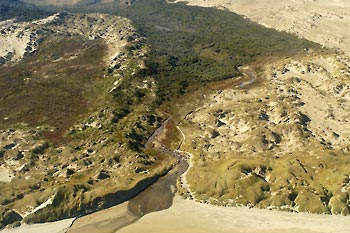 Masons Bay
liegt auf der anderen Seite der Insel. Die Experten sind sich einig. Der
Ort ist einzigartig, man muss ihn gesehen haben. Es gibt verschiedene Wege
wie man dahin kommen kann. Man kann von Halfmoon Bay in verschiedenen
Tagesetappen über einen der grossen Tracks hinwandern. Man kann in
Halfmoon Bay ein Wassertaxi nehmen und bei Flut den Freshwater River
hinauffahren. Von da sind es noch 14 km Wandern quer über die Insel, durch
eine vorgeschichtliche Ebene die mit Sümpfen durchzogen ist. Dies muss
jedoch bis zur nächsten Ebbe, das heisst innerhalb 6 Stunden geschehen,
sonst sitzt man in Masons Bay fest. Man kann auch bei Ebbe nach Masons Bay
fliegen, auf dem Strand landen und dann innert 6 Stunden (bis zur Flut,
siehe oben) durch die besagte 14 km Ebene wandern. Landen in Masons Bay
geht nur bei Ebbe, da ausser dem Strand keine geraden Flächen da sind.
Fragt mich nach der Landung mit dem Wasserflugzeug, ich werde sie euch
später beantworten. Sechs Stunden für die Überquerung sind zwar machbar,
auch für uns, allerdings wenn ich Beats Gejammer über seine Füsse
bedenke.. Viel wichtiger ist uns jedoch, genügend Zeit zu haben die Masons
Bay zu erkunden, Photos zu machen, Pflanzen und Tiere zu bestaunen und
vielleicht sogar einem Kiwi (gefiedert) zu begegnen. Da bleibt nicht mehr
viel Zeit für die 14 km. Masons Bay
liegt auf der anderen Seite der Insel. Die Experten sind sich einig. Der
Ort ist einzigartig, man muss ihn gesehen haben. Es gibt verschiedene Wege
wie man dahin kommen kann. Man kann von Halfmoon Bay in verschiedenen
Tagesetappen über einen der grossen Tracks hinwandern. Man kann in
Halfmoon Bay ein Wassertaxi nehmen und bei Flut den Freshwater River
hinauffahren. Von da sind es noch 14 km Wandern quer über die Insel, durch
eine vorgeschichtliche Ebene die mit Sümpfen durchzogen ist. Dies muss
jedoch bis zur nächsten Ebbe, das heisst innerhalb 6 Stunden geschehen,
sonst sitzt man in Masons Bay fest. Man kann auch bei Ebbe nach Masons Bay
fliegen, auf dem Strand landen und dann innert 6 Stunden (bis zur Flut,
siehe oben) durch die besagte 14 km Ebene wandern. Landen in Masons Bay
geht nur bei Ebbe, da ausser dem Strand keine geraden Flächen da sind.
Fragt mich nach der Landung mit dem Wasserflugzeug, ich werde sie euch
später beantworten. Sechs Stunden für die Überquerung sind zwar machbar,
auch für uns, allerdings wenn ich Beats Gejammer über seine Füsse
bedenke.. Viel wichtiger ist uns jedoch, genügend Zeit zu haben die Masons
Bay zu erkunden, Photos zu machen, Pflanzen und Tiere zu bestaunen und
vielleicht sogar einem Kiwi (gefiedert) zu begegnen. Da bleibt nicht mehr
viel Zeit für die 14 km.
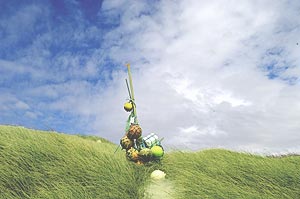 Man
könnte natürlich die eine oder andere Variante wählen und entweder in der
Hütte bei Masons Bay oder bei Freshwater Landing übernachten, dann hätte
man viel länger Zeit für die Inselüberquerung. Die Hütten sind soweit sehr
komfortabel mit 4er Schlägen und Kajütenbetten und einem Gemeinschaftsraum
mit fliessend kaltem Wasser ausgestattet. Das Essen, den Kocher, die
Pfannen und den Schlafsack etc. muss man allerdings selber mitbringen. Nun
haben Beat und ich ja geübt in den letzten Wochen und unsere Fitness enorm
gesteigert. Aber 14 km durch Busch und Sümpfe mit einem Einfamilienhaus
auf dem Rücken, ich weiss nicht..... unsere Begeisterung hält sich in sehr
engen Grenzen. Man
könnte natürlich die eine oder andere Variante wählen und entweder in der
Hütte bei Masons Bay oder bei Freshwater Landing übernachten, dann hätte
man viel länger Zeit für die Inselüberquerung. Die Hütten sind soweit sehr
komfortabel mit 4er Schlägen und Kajütenbetten und einem Gemeinschaftsraum
mit fliessend kaltem Wasser ausgestattet. Das Essen, den Kocher, die
Pfannen und den Schlafsack etc. muss man allerdings selber mitbringen. Nun
haben Beat und ich ja geübt in den letzten Wochen und unsere Fitness enorm
gesteigert. Aber 14 km durch Busch und Sümpfe mit einem Einfamilienhaus
auf dem Rücken, ich weiss nicht..... unsere Begeisterung hält sich in sehr
engen Grenzen.
 Also sind unsere grauen Zellen gefragt. Wir wollen nämlich unbedingt hin
(und haben es ja auch geschafft, wie die Photos zeigen). Es gibt pro Monat
zwei bis drei Tage, an denen die Ebbe zweimal bei Tageslicht stattfindet.
Wir haben uns den Sonntag ausgesucht und auf gutes Wetter und freie Sitze
im 5 plätzigen Flugzeug
gehofft. Es hat geklappt. Raymond, Mitbegründer und –Besitzer der Stewart
Island Flights, holte uns um 0730 in Halfmoon Bay ab. Er macht den Safety
Check inklusive Schwimmweste, und zieht los. Beat sitzt vorne als
Co-Pilot. Hinter mir hat es noch Kisten, die irgendwelche Waren bergen. Es
regnet noch. Raymond meldet sich vorschriftsmässig in Invercargill ab und
wir fliegen über Paterson Inlet. Jetzt verstehe ich das Problem mit der
Einfahrt in den Freshwater River bei Ebbe. Eine riesige Sandbank ist quer
über der ganzen Bucht sichtbar und versperrt die Einfahrt zum Fluss. Schon
fliegen wir über die Ebene und die riesigen Sanddünen die Masons Bay so
speziell machen. Raymond fliegt einmal den Strand hinauf um zu checken ob
der Sand genügen hält und schon setzt die Maschine auf und rollt zu ein
paar Figuren am Strand. Beim Aussteigen muss es blitzig gehen. Die Wellen
gehen ziemlich hoch, ca 4 m und wir müssen die Maschine schnell in
Sicherheit schieben. Also sind unsere grauen Zellen gefragt. Wir wollen nämlich unbedingt hin
(und haben es ja auch geschafft, wie die Photos zeigen). Es gibt pro Monat
zwei bis drei Tage, an denen die Ebbe zweimal bei Tageslicht stattfindet.
Wir haben uns den Sonntag ausgesucht und auf gutes Wetter und freie Sitze
im 5 plätzigen Flugzeug
gehofft. Es hat geklappt. Raymond, Mitbegründer und –Besitzer der Stewart
Island Flights, holte uns um 0730 in Halfmoon Bay ab. Er macht den Safety
Check inklusive Schwimmweste, und zieht los. Beat sitzt vorne als
Co-Pilot. Hinter mir hat es noch Kisten, die irgendwelche Waren bergen. Es
regnet noch. Raymond meldet sich vorschriftsmässig in Invercargill ab und
wir fliegen über Paterson Inlet. Jetzt verstehe ich das Problem mit der
Einfahrt in den Freshwater River bei Ebbe. Eine riesige Sandbank ist quer
über der ganzen Bucht sichtbar und versperrt die Einfahrt zum Fluss. Schon
fliegen wir über die Ebene und die riesigen Sanddünen die Masons Bay so
speziell machen. Raymond fliegt einmal den Strand hinauf um zu checken ob
der Sand genügen hält und schon setzt die Maschine auf und rollt zu ein
paar Figuren am Strand. Beim Aussteigen muss es blitzig gehen. Die Wellen
gehen ziemlich hoch, ca 4 m und wir müssen die Maschine schnell in
Sicherheit schieben.
 Die Figuren kommen zum Flugzeug, es hat gerade eine Ablösung beim
Hüttenwart geben. Die Neue kommt aus England und ist wie die meisten hier,
für 14 Tage freiwillig in die Einsamkeit gezogen. Raymond lädt einige
Harasse und Säcke mit Lebensmittel aus, lädt die neuen Passagiere ein und
fliegt nach Invercargill zurück. Wir bieten der Hüttenwartin Hilfe beim
Transport der Lebensmittel für die nächsten 2 Wochen an. Sie lehnt
freundlich ab, nimmt einen Rucksack voll mit und will später mit einer
Schubkarre wieder kommen und den Rest holen. Es sind ja ca. 5 Stunden bis
zur nächsten Flut. Die Figuren kommen zum Flugzeug, es hat gerade eine Ablösung beim
Hüttenwart geben. Die Neue kommt aus England und ist wie die meisten hier,
für 14 Tage freiwillig in die Einsamkeit gezogen. Raymond lädt einige
Harasse und Säcke mit Lebensmittel aus, lädt die neuen Passagiere ein und
fliegt nach Invercargill zurück. Wir bieten der Hüttenwartin Hilfe beim
Transport der Lebensmittel für die nächsten 2 Wochen an. Sie lehnt
freundlich ab, nimmt einen Rucksack voll mit und will später mit einer
Schubkarre wieder kommen und den Rest holen. Es sind ja ca. 5 Stunden bis
zur nächsten Flut.
Nun haben wir Zeit um uns umzusehen. Es ist noch diesig am Morgen aber der
riesige Strand in einem grossen Halbrund ist gut zu sehen, sowie die Berge
die ihn auf beiden Seiten begrenzen. Habe ich beide Seiten gesagt? Auch
auf die Meeresseite häufen sich Berge von schäumendem blau, grau, braunem
Wasser, das heftig gegen die Küste knallt. Von hier über den Pazifik ist
das nächste Land Chile. So kommt die Brandung ungehemmt an den Strand und
beantwortet gleichzeitig die Frage nach der Landung mit einem
Wasserflugzeug. Kilometerweise Strand, und kein einziges Badeschirmchen
oder Liegestuhl. Paradiesisch.
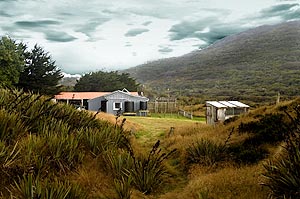 Wir beschliessen
zuerst in die Dünen zu wandern. Es erwartet und eine unwirtliche
mondgleiche Landschaft. Völlig urtümlich. Man erwartet jederzeit einem
Dinosaurier zu begegnen. So weit ist das gar nicht hergeholt. Im Paterson
Inlet leben noch so genannte Brachiopoden, Muscheln die über 300 Millionen
Jahre alt sind und sich nicht verändert haben. So gibt es in Neuseeland
auch noch den Tuatara, ein letzter Überlebender der Dinosaurier die vor
Millionen von Jahren schon auf der Erde lebten. Der Tuatara ist allerdings
nicht sehr gross, etwa 50 cm lang und sieht wie eine grosse Echse aus. Wir beschliessen
zuerst in die Dünen zu wandern. Es erwartet und eine unwirtliche
mondgleiche Landschaft. Völlig urtümlich. Man erwartet jederzeit einem
Dinosaurier zu begegnen. So weit ist das gar nicht hergeholt. Im Paterson
Inlet leben noch so genannte Brachiopoden, Muscheln die über 300 Millionen
Jahre alt sind und sich nicht verändert haben. So gibt es in Neuseeland
auch noch den Tuatara, ein letzter Überlebender der Dinosaurier die vor
Millionen von Jahren schon auf der Erde lebten. Der Tuatara ist allerdings
nicht sehr gross, etwa 50 cm lang und sieht wie eine grosse Echse aus.
Hinter den Dünen beginnt eine grosse Ebene mit Hügeln und dem roten
Tussock Grass. In dieser unwirtlichen Gegend haben Ende des 19.
Jahrhunderts verschiedene Farmer ihr Glück versucht. Einem Schaffarmer
wurden die Sümpfe zum Verhängnis. Die nächsten versuchten es näher an den
Sanddünen. Sie transportierten ihre Wolle mit Pferdewagen und später
Traktoren zur Freshwater River oder zur Masons Bay von wo sie verschifft
wurde. Keine einfache Arbeit. Ein Farmer hat sich sogar ein Ford Modell T
angeschafft um die schon damals zahlreichen Touristen herumzuführen. Bis
1986 hielten die verschiedenen Anstrengungen an, aber der karge Boden und
die teuren Transportwege zwangen auch den letzten zur Aufgabe. Das Land
wurde vom Department of Conservation übernommen und gehört jetzt zum
Nationalpark.
 Der
Schafstall steht noch, ebenso der rostige Traktor und das ehemalige
Bauernhaus. Das wurde etwas renoviert und beherbergt jetzt die
freiwilligen Hüttenwarte. Auf dem Rückweg von unseren Erkundigungen sahen
wir dicken Rauch aus dem Kamin und aus der Türe quellen. Die Hüttenwartin
sass vor dem Eingang mit den Füssen in einem Eimer Wasser und bemerkte,
schon fast prophetisch, dass sie einen harten langen Tag vor sich hätte.
Das Bauernhaus hat einen Kohleofen, der fürs Kochen und für heisses Wasser
sorgt. Allerdings hat die Londoner Hüttenwartin noch nie mit so einem Ding
gekocht. Ich fühlte mit ihr und war an meine ersten Brotbackkünste
erinnert. Der Rauch verzog sich langsam sie konnte sich einen Tee brauen.
Die Schubkarre stand noch immer unbenutzt vor dem Haus. Es war kurz vor
Mittag. Der
Schafstall steht noch, ebenso der rostige Traktor und das ehemalige
Bauernhaus. Das wurde etwas renoviert und beherbergt jetzt die
freiwilligen Hüttenwarte. Auf dem Rückweg von unseren Erkundigungen sahen
wir dicken Rauch aus dem Kamin und aus der Türe quellen. Die Hüttenwartin
sass vor dem Eingang mit den Füssen in einem Eimer Wasser und bemerkte,
schon fast prophetisch, dass sie einen harten langen Tag vor sich hätte.
Das Bauernhaus hat einen Kohleofen, der fürs Kochen und für heisses Wasser
sorgt. Allerdings hat die Londoner Hüttenwartin noch nie mit so einem Ding
gekocht. Ich fühlte mit ihr und war an meine ersten Brotbackkünste
erinnert. Der Rauch verzog sich langsam sie konnte sich einen Tee brauen.
Die Schubkarre stand noch immer unbenutzt vor dem Haus. Es war kurz vor
Mittag.
Auf dem Weg zur Hütte haben Beat und ich versucht einen Kiwi zu erspähen.
Wir haben von vielen Leuten gehört, dass sie einen Freund hätten, der
einen Kollegen hat, dessen Onkel ganz bestimmt hier schon einen Kiwi
gesehen hätte. Nun, uns war es nicht vergönnt. Die nachtaktiven, nicht
fliegenden Vögel hielten sich versteckt. Bei der Hütte war eine
Touristengruppe aktiv die ein grosses Zelt aufstellte. Einige Teilnehmende
sahen schon etwas ramponiert aus und legten sich ein wenig hin. Sie hatten
noch nicht einmal die 14 km hinter sich. Es stellte sich heraus, dass die
Leiterin, Marianne, aus dem Toggenburg kommt und auch noch als
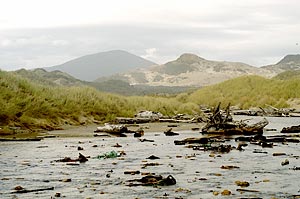 Lehrerin in
Neuseeland arbeitet. Sie kam mit ihrer Gruppe um 11 Uhr vom Strand her und
stolperte fast über Cornflakes, Spaghetti, Dosen, Wein im Plastiksack und
einem Kaffeetopf, die von den Wellen hin und her geworfen wurden. Sie
sammelten auf was noch rettbar schien und stellten die Harasse auf eine
Düne. Die Flut kommt zur Zeit mit einem Hub von 2.80 m herein und es
bleibt kein Strandstreifen mehr trocken. Endlich kommt die Hüttenwartin
mit Ihrer Schubkarre heranmarschiert. Vielleicht nicht das ideale Gerät um
im tiefen Sand schwere Güter zu transportieren. Das hat sie denn auch
eingesehen und hat die Karre auf halbem Weg liegengelassen. Sie füllte
ihren Rucksack wieder mit dem Nötigsten und wollte dann bei Ebbe
wiederkommen und den Rest holen. Wir haben sie allerdings bis zur Ebbe
nicht mehr gesehen, und die Cornflakes waren immer noch am Strand, als wir
um 18.30 wieder abflogen. Lehrerin in
Neuseeland arbeitet. Sie kam mit ihrer Gruppe um 11 Uhr vom Strand her und
stolperte fast über Cornflakes, Spaghetti, Dosen, Wein im Plastiksack und
einem Kaffeetopf, die von den Wellen hin und her geworfen wurden. Sie
sammelten auf was noch rettbar schien und stellten die Harasse auf eine
Düne. Die Flut kommt zur Zeit mit einem Hub von 2.80 m herein und es
bleibt kein Strandstreifen mehr trocken. Endlich kommt die Hüttenwartin
mit Ihrer Schubkarre heranmarschiert. Vielleicht nicht das ideale Gerät um
im tiefen Sand schwere Güter zu transportieren. Das hat sie denn auch
eingesehen und hat die Karre auf halbem Weg liegengelassen. Sie füllte
ihren Rucksack wieder mit dem Nötigsten und wollte dann bei Ebbe
wiederkommen und den Rest holen. Wir haben sie allerdings bis zur Ebbe
nicht mehr gesehen, und die Cornflakes waren immer noch am Strand, als wir
um 18.30 wieder abflogen.
Diesmal kam Raymond mit einem 10-Plätzer, da er noch eine Jagdgesellschaft
etwas weiter unten abgesetzt hatte und nach uns noch einmal eine Gruppe
herfliegen soll. Auf dem Heimflug konnte ich vorne sitzen und wieder den
völlig professionellen Sprechfunkverkehr mit Invercargill Traffic Control
und Ryan Creek Airfield (Stewart Island) mit anhören. Das ist umso
interessanter, wenn man weiss, dass auf Stewart Island die Post und das
Flugbüro ein und dasselbe sind. Das Ein- bis Zweipersonen Team macht
alles, vom einchecken, Marken kleben, Bus zum Airstrip fahren und eben
Funkanweisungen geben. In unserem Falle war es: „Ja, ich war gerade oben,
sieht gut aus, es hat keine Äste auf die Piste geweht.“
Raymond ist nur einmal von der Routine abgewichen. Er hat Invercargill
Tower angefragt, wie es im Amerikas Cup stünde. Die Kiwis hatten einen
guten Start und führten zwischenzeitlich mit 35 Sekunden. Invercargill
Tower meldete: 2 zu 0 für Alinghi um nur 7 Sekunden.
Was uns jedoch wirklich beschäftigt ist: Wie sieht es nun beim Freshwater
River aus?
MASON BAY
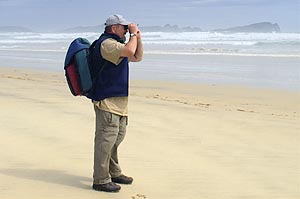 Masons
Bay lies on the opposite Side of the Island. The experts all agree. It is
unique and precious, a definite Must See. There are various ways of
getting there. One can hike from Halfmoon Bay. It takes several days over
one of the big tracks. One can take a watertaxi in Halfmoon Bay and ride
up the Freshwater River, but only at high tide. Then there are 14 km
hiking across the Island, through an archaic valley, which is interspersed
with swamps. This has to be done until the next ebb tide, i.e. in 6 hours;
otherwise one is stranded in Masons Bay. One can also fly to Masons Bay,
only at ebb tide and land on the sand. Then there is the 14 km hike back
to Freshwater River until next high tide (see above). The plane can only
land in Masons Bay at ebb tide, because there is no other airstrip there.
Ask me why we do not take an Aquaplane. I will answer later. Six hours to
hike the 14 km stretch is certainly doable, even for us, however thinking
of Beats moaning about his feet…. Much more important it is however, to
have enough time to wander around in Masons Bay, take photos, admire
plants and animals and maybe even have an encounter with a Kiwi (a
feathered one). Then there is not much time left for the 14 km. Masons
Bay lies on the opposite Side of the Island. The experts all agree. It is
unique and precious, a definite Must See. There are various ways of
getting there. One can hike from Halfmoon Bay. It takes several days over
one of the big tracks. One can take a watertaxi in Halfmoon Bay and ride
up the Freshwater River, but only at high tide. Then there are 14 km
hiking across the Island, through an archaic valley, which is interspersed
with swamps. This has to be done until the next ebb tide, i.e. in 6 hours;
otherwise one is stranded in Masons Bay. One can also fly to Masons Bay,
only at ebb tide and land on the sand. Then there is the 14 km hike back
to Freshwater River until next high tide (see above). The plane can only
land in Masons Bay at ebb tide, because there is no other airstrip there.
Ask me why we do not take an Aquaplane. I will answer later. Six hours to
hike the 14 km stretch is certainly doable, even for us, however thinking
of Beats moaning about his feet…. Much more important it is however, to
have enough time to wander around in Masons Bay, take photos, admire
plants and animals and maybe even have an encounter with a Kiwi (a
feathered one). Then there is not much time left for the 14 km.
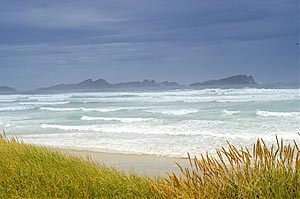 Of course one could
choose one or the other alternative and either stay in the hut at Masons
Bay or Freshwater for one night. Then there would be ample time for
crossing the Island. The huts are quite comfortable as huts go. There are
various sleeping rooms with bunk beds, a common room/kitchen with cold
water. The food, the cooker, cooking gear, sleeping bag, however, one has
to bring oneself. Now Beat and I have been about quite a bit in the past
couple of weeks and have increased our level of fitness enormously. But 14
km through bush and swamps with a family home on the back? I don’t know…..
, our enthusiasm seems to be minimesimal. Of course one could
choose one or the other alternative and either stay in the hut at Masons
Bay or Freshwater for one night. Then there would be ample time for
crossing the Island. The huts are quite comfortable as huts go. There are
various sleeping rooms with bunk beds, a common room/kitchen with cold
water. The food, the cooker, cooking gear, sleeping bag, however, one has
to bring oneself. Now Beat and I have been about quite a bit in the past
couple of weeks and have increased our level of fitness enormously. But 14
km through bush and swamps with a family home on the back? I don’t know…..
, our enthusiasm seems to be minimesimal.
So, we had to use our grey cells. We really wanted to go to Masons Bay
(and have managed it as our photos show). There are a couple of days per
month where the ebb tide occurs twice in a day during daylight. We have
chosen this Sunday and have hoped for good weather, and free seats in 5
seated Airplane. It has worked. Raymond, Co-founder and –owner of Stewart
Island Flights got us at 0730 in Halfmoon Bay. He did the safety check
including swim vests and took off. Beat sits in front as Co-Pilot. Behind
me there are some crates with goods. It still rains a bit. Raymond gives
our position to Invercargill Traffic control and we fly over Paterson
Inlet. Now I understand, why the water taxi can only go up the Freshwater
river at low tide. There is an enormous sandbank right in front of the
river delta. We are already flying over a large valley and the sand dunes,
which make Masons Bay so special, are in sight. Raymond flies once over
the bay and checks whether the sand has the right consistency to land and
there he goes smoothly unto the beach. The plane rolls slowly towards a
group of waiting people. All of a sudden we have to get off the plan in a
hurry, because the waves with a swell of about 4 meters threaten the
plane. We quickly push it a bit further up the beach to safety.
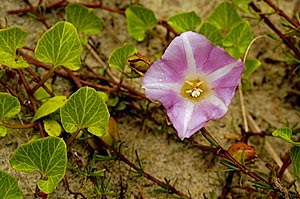 The people
come up to the plane. There has been a change of the hut warden. The new
one comes from England and like most, stays for about 2 weeks as a
voluntary helper in the remote area. Raymond has unloaded some crates and
bags full of food for the hut warden, loads the new passengers and flies
back to Invercargill. The people
come up to the plane. There has been a change of the hut warden. The new
one comes from England and like most, stays for about 2 weeks as a
voluntary helper in the remote area. Raymond has unloaded some crates and
bags full of food for the hut warden, loads the new passengers and flies
back to Invercargill.
We offer the hut warden some help with her food for the next two weeks,
but she declines nicely, packs a back pack full of food and says that she
wants to come later with a wheelbarrow to get the rest. There are another
5 hours until the next high tide.
Now we have time to look around. It is still a bit hazy in the morning,
but the long beach which forms a very large half circle is visible, as
well as mountains at both ends. Did I say both ends? There are also the
mountainous 4 m high blue, grey and brown waves with froth on top which
thunder forcefully against the beach. From here over the Pacific, there is
nothing, which has stopped them since Chile. This also answers the
question about the landing with an Aqua plane. Miles and miles of sandy
beaches, no large Umbrellas against the sun or beach beds with reserving
towels. Paradise!
We decide to explore the dunes first. We are greeted with an unreal und
moonlike landscape. Totally archaic. Behind every dune could wait a
dinosaur for us. This is not as far fetched as it sounds. In Paterson
Inlet live Brachiopods; these are clam-like animals, which have remained
unchanged for 300 million years. New Zealand has also the only surviving
animal of the dinosaur generation, which roamed the earth millions of
years ago, the Tuatara. This is a reptile which could grow to about half a
meter and looks somewhat like a gecko.
Behind the dunes starts a large valley with sandy hills and the lovely red
tussock grass. In this unwelcoming landscape there have been several
attempts at farming end of the 19th century. One of the farmers had to
give up because of all the swampland, which did not agree with his sheep.
Others tried closer to the sand dunes. They transported their wool with
horse and wagon or tractors either to Masons Bay or Freshwater River in
order to ship it out. No easy task. One farmer even got a Ford Model T in
order to transport the already then numerous tourists. The last farmer
gave up in 1986. The poor soil and the expensive ways of transporting the
wool made farming unprofitable. The land has been sold to the Department
of Conservation und belongs to new National Park.
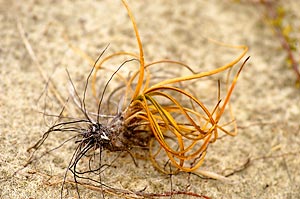 The sheep sty is still
there, so is the rusty tractor and the old homestead. It was renovated
somewhat and now houses the hut wardens for the Masons Bay DoC hut. On our
way back from our expedition we saw thick smoke coming out of the chimney
and the door of the old homestead. The hut warden was sitting on the porch
with her feet soaked in a bucket. She remarked, somewhat prophetic, that
it was going to be a long, hard day. The homestead has a coal range to
cook and make hot water. However, the hut warden from London had never
used one before. I felt with her, thinking about my first bread-baking try.
The smoke became somewhat thinner and she was able to get herself some
tea. The wheelbarrow stood still unused in front of the house. It was
shortly before noon. The sheep sty is still
there, so is the rusty tractor and the old homestead. It was renovated
somewhat and now houses the hut wardens for the Masons Bay DoC hut. On our
way back from our expedition we saw thick smoke coming out of the chimney
and the door of the old homestead. The hut warden was sitting on the porch
with her feet soaked in a bucket. She remarked, somewhat prophetic, that
it was going to be a long, hard day. The homestead has a coal range to
cook and make hot water. However, the hut warden from London had never
used one before. I felt with her, thinking about my first bread-baking try.
The smoke became somewhat thinner and she was able to get herself some
tea. The wheelbarrow stood still unused in front of the house. It was
shortly before noon.
On our way to the DoC hut Beat and I tried to get a glimpse of a Kiwi. We
have heard from so many people who had a friend, who have a colleague,
whose uncle definitely has already seen a Kiwi right here. Well, we were
not in that lucky position. These night active flightless birds kept to
themselves on that day. At the hut we encountered a group of tourists,
which were about to set up a huge tent. Some of them looked already a bit
worse for wear and went for a siesta. They hadn’t even hiked the 14 km yet.
It turned out, that their guide was a Swiss named Marianne who came from
Toggenburg. She also works as a teacher in New Zealand. She came with her
group at about eleven o clock from the beach, where she almost fell over
some cornflakes, some spaghetti in a tin, wine in a plastic bag and a
coffeepot, which were thrown back and forth by the waves. The group got as
much of the food, which was still usable up to a dry place. The tide comes
presently with a tidal hub of 2.80 m, which leaves no sand dry on the
beach. Finally the hut warden marched up with her wheelbarrow. Maybe not
the right kind of vehicle to pull heavy weights through deep sand? She
must have thought so herself, because she left the wheelbarrow halfway
down to the beach. She got some food into her backpack and announced that
she would get the rest at low tide, when we would fly out again. It so
happens, that we haven’t seen her again, the cornflakes were still there
when we left at 6.30 pm.
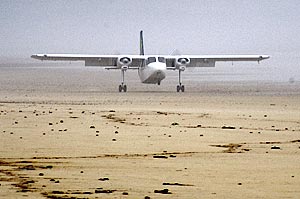 This time
Raymond came with a 10-seated plane, because he had to load off a hunting
party at the other end of the beach and wanted to bring another group out
to Masons Bay the same evening. On the way home it was my turn to sit in
front. Again the very professional communication with Invercargill Traffic
Control and Ryan Creek Airfield (Stewart Island). This was all the more
interesting, because on Stewart Island the Post Office and the Flight
centre are one and the same people. The one or two people team do all the
jobs. They do the check-in, loading sheets for the pilot, sell stamps,
sort mail, drive the bus to the Airfield and are on the other side of the
flight communication. This time it was: “Yes I have just been up there,
the strip is free, nothing has been blown unto the runway.” This time
Raymond came with a 10-seated plane, because he had to load off a hunting
party at the other end of the beach and wanted to bring another group out
to Masons Bay the same evening. On the way home it was my turn to sit in
front. Again the very professional communication with Invercargill Traffic
Control and Ryan Creek Airfield (Stewart Island). This was all the more
interesting, because on Stewart Island the Post Office and the Flight
centre are one and the same people. The one or two people team do all the
jobs. They do the check-in, loading sheets for the pilot, sell stamps,
sort mail, drive the bus to the Airfield and are on the other side of the
flight communication. This time it was: “Yes I have just been up there,
the strip is free, nothing has been blown unto the runway.”
Raymond strayed only once from the routine. He asked Invercargill Tower
about the result of today’s Americas Cup race. The Kiwis were off to a
good start and had at one time a gain of 35 seconds. Invercargill Tower
came back: “2 to 0 for Alinghi with 7 seconds only.”
What we are really wondering about of course is: How does it look at
Freshwater River landing?
.
|